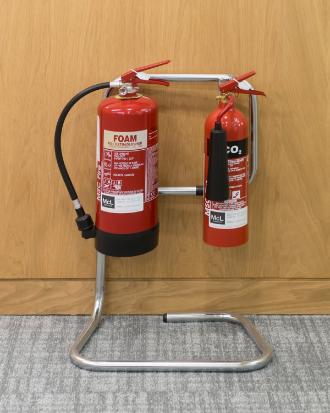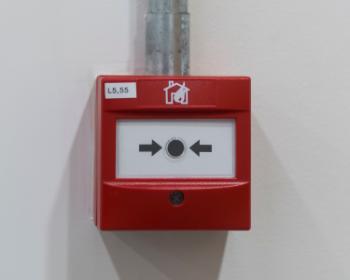A Personal Evacuation Plan ( PEEP) is taking time to plan in advance how to get out of a building safely in the case of an emergency. It is being aware of refuge areas and possible evacuation routes.
Personal Emergency Evacuations Plans
A Guide to personal safety in the case of an emergency
It is important that all UCD students are aware of how to get out safely from a building in the case of an emergency. For students with mobility issues there are some additional considerations they need to be aware of.
This webpage provides practical information and tips to prepare students for getting out of a building safely. It is important that everyone understands that planning for an emergency evacuation is about planning for exceptional circumstances, not an everyday occurrence.
The purpose of a PEEP is to help students plan their safe passage out of a building in the event of an emergency. Such a plan will consider any challenges that a student may face in evacuating a university building. Students should always make themselves aware of their surroundings when accessing buildings, especially for the first time or buildings that they only access infrequently and always note that the quickest way to exit a building in an emergency is not always the way that they accessed the building.
Students with an impairment or disability such as:
- Mobility impairment, accompanied by an assistant or use a guide dog
- Sensory impairments
- Mental health impairment, where the capacity to process information quickly is affected
- hidden disabilities where the disability is not physically apparent, but the stress of an emergency situation may trigger the condition.
Thinking about the main buildings you use regularly, answer the following questions.
- Would I be able to exit a building in an emergency safely and quickly and without assistance?
- Can I exit the building safely if the lift is unavailable? (Remember, if there is an emergency in any building, lifts will be unavailable.)
- Do I know what a refuge area is and how to use one?
- Do I have the Campus services 24hr emergency number – 07-716-7999 in my phone?
- Can I recognize and use a fire alarm activation device?
If you answer NO to any of the questions below, please use this website to find out more on what actions you need to take for your personal safety in an emergency.
Students should assess each building that they attend on a regular basis and plan how they can exit safely based on their individual needs. Students should make themselves aware of alternative access and egress routes in buildings frequented. Note that the easiest or quickest way out of a building in an emergency is not always the same way that you accessed the building. This is easily done by looking for the green man running signs around campus.
It is important that UCD students familiarise themselves with the key safety points and evacuation procedures outlined below.
EVACUATION PROCEDURES
IF YOU HEAR THE FIRE ALARM
- Do not panic but prepare to leave the building.
- The alarm will sound continuously; leave the building immediately in an orderly fashion by following the green man running signs to the nearest exit. Please note that this may not be the same way you entered the building.


Image: Emergency Fire exit to the left Image: Emergency Fire Exit
- Classes in session must be dismissed and students directed to leave.
- Persons in laboratories and workshops must make the area safe before leaving.
- Do not use lifts.
- Do not go back to your working area for any reason.
- If for any reason you are unable to leave the building, make your way to a protected stairwell or a room with an external window and shut the door. If possible, inform the emergency line (ext. 7999) or a colleague of your location and the reason you cannot safely exit the building.
- Proceed to the nearest emergency assembly area to your point of departure from the building.
The individual evacuation assembly area for each buildings in UCD are shown in the interactive map and listed below
- Report any knowledge you may have of missing or injured persons to a fire marshal / services personnel.
- Return to the building only after the chief fire marshal / services personnel has given the all clear signal.
IF YOU OBSERVE A FIRE
- Activate the fire alarm by breaking one of the red wall mounted break glass units located throughout the buildings and if possible, inform the emergency line (ext. 7999).
- If it is safe to do so and if you are trained to do so, the fire may be tackled using a suitable fire extinguisher, but only if this does not place any person at risk of injury and you have a safe and clear means of escape from the fire at all times.
- In the event that you cannot fight the fire, or the fire begins to get out of control, evacuate the area immediately.
A Refuge Point is a space where those who cannot use the stairs (e.g. wheelchair users), can safely wait for assistance. Refuge areas are located in areas of relative safety. Refuges can be designated spaces in newer buildings or other suitable spaces such as classrooms with windows (usually in older buildings).
UCD students should familiarise themselves with refuge areas and how they are used. As part of any evacuation plan the refuges in the buildings under review will be identified.
What is a refuge area and who should use it?
An area of refuge is a location in a building designated to hold occupants during a fire or other emergency, when evacuation may not be safe or possible. Occupants can wait there until rescued or relieved by firefighters. This can apply to the following.
- Any person who cannot access a safe escape route
- Any persons assisting another person who is prevented from escaping
- People with disabilities
Personal Emergency Egress Plans (PEEP’s) are ‘personal’ plans that are tailored to an individual’s needs and help address the challenges individual staff members or students may have to face in evacuating a university building in an emergency. Provided by UCD Access and Lifelong Learning office.
Many refuge areas have dedicated communications equipment designed to be safely used in a fire, that connects either to a dedicated point near the entrance to the building or directly to Estate Services. See below
Example of an intercom in a refuge area
Example of a fire extinguisher

Examples of red fire alarm button

Examples of Green running man
 green running man emergncy route -380x304.jpg)
The Green running man will show the route to the nearest exit
If you have studied the information on the website and feel you would require further assistance to create a plan to get out of the building safely during an emergency, please email (opens in a new window)disability@ucd.ie. A member of staff will contact you to arrange this.
This list has details of the Refuge Points across the campus.